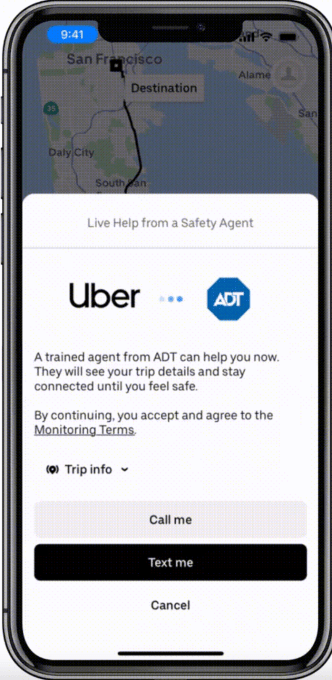Uber is introducing a new option to its safety toolkit, a section of Uber’s app where users can contact emergency services, report a safety issue to the company, verify rides with a one-of-a-kind PIN code, share trip status and more. Now, Uber has partnered with security company ADT to let riders contact an ADT agent during trips. Uber is also extending its 911 text feature to more U.S. customers across all 50 states. The safety toolkit has been revamped as well to give users easier access to the tools.
With the new “Live Help” feature, users have access to a live safety agent from ADT via call or text. The agent helps riders with issues that aren’t considered an emergency but still make them feel unsafe. The ADT agent will work with the rider throughout the trip, staying on the phone with them to monitor the situation or call 911 if the situation escalates.
Last year, DoorDash partnered with ADT to launch a similar feature to its in-app security toolkit “SafeDash,” letting users contact a live ADT agent.
With Uber’s new partnership with ADT, riders may feel safer knowing that a third party is there when extra guidance or assistance is needed.
“We hope this new feature will give users additional peace of mind knowing that help is available right in the app for any safety situation,” Rebecca Payne, lead safety product manager, Uber, wrote in an official blog.
The company has expanded the ability to text 911, making the safety feature available to almost 60% of the United States, including New York City and all of California. The feature is not available in Milwaukee due to “local ordinance requirements.” Initially, when the feature launched in 2019, it was only for riders in Los Angeles, Minnesota and Indiana. Riders can text information to emergency dispatchers, allowing users to request help quicker and more discreetly.
Uber’s upgraded safety toolkit will also get a new look, allowing more direct access to the in-app feature. When tapping on the blue shield icon, riders will see a group of essential safety tools as four large blocks. The company claims it wants to “streamline access to and visibility” of the transportation app’s most important safety features in case the rider needs immediate emergency assistance. This includes “Contact 911,” “Contact safety agent,” “Share trip status” and “Report safety issue.” Users can swipe to find more of Uber’s safety tools.
After facing criticism for mishandling sexual assault incidents, Uber has been reworking its safety toolkit to help users address more safety concerns. The company also claims its rides are getting safer. According to its 2019-2020 U.S. Safety Report, 99.9% of trips had no incidents, and there was a 38% decrease in sexual assaults compared to the 2017-2018 report.
Uber rolled out its safety toolkit in 2018. Since the launch, the company has added an audio recording feature, on-trip reporting, a RideCheck feature that checks in with both rider and driver if the system suspects there was a crash and more.











